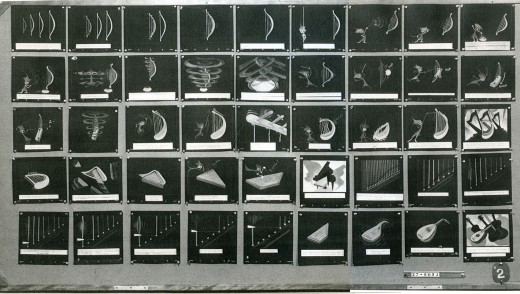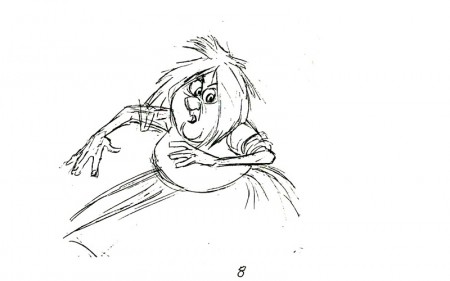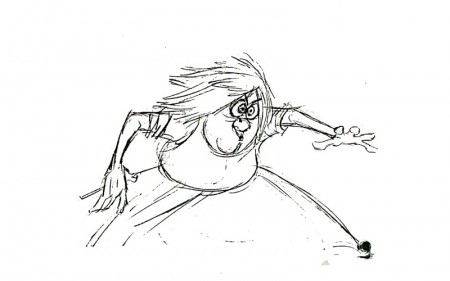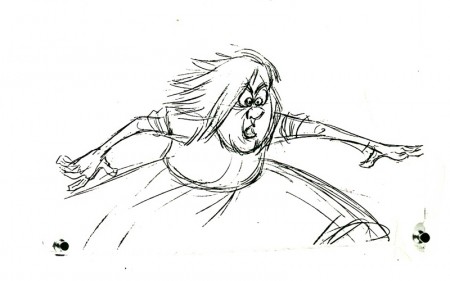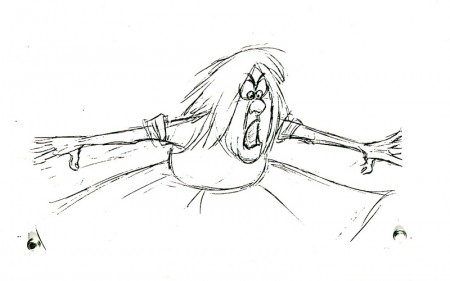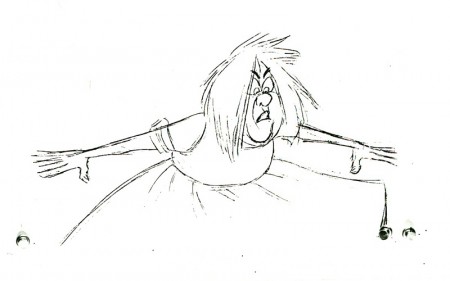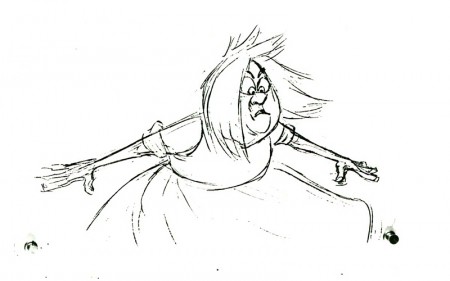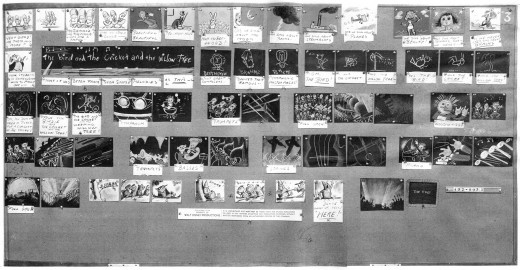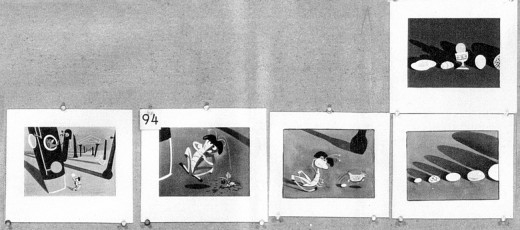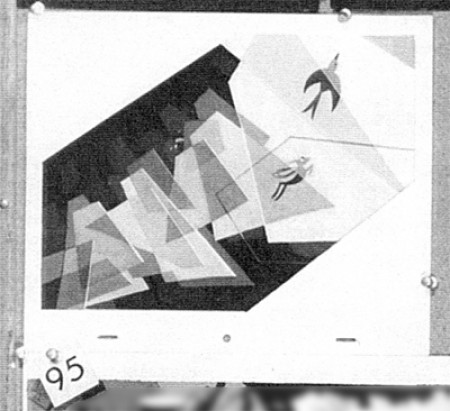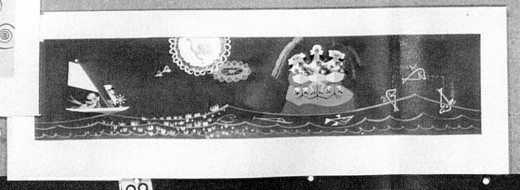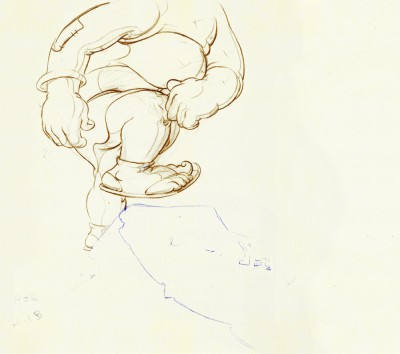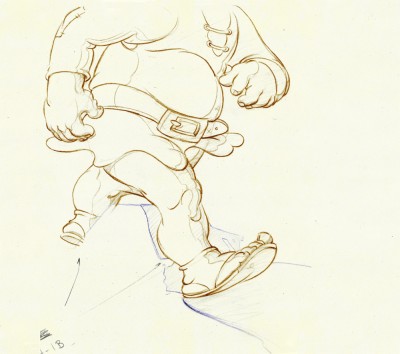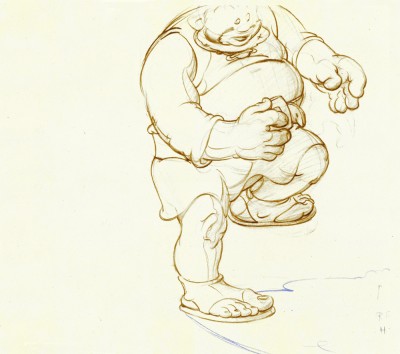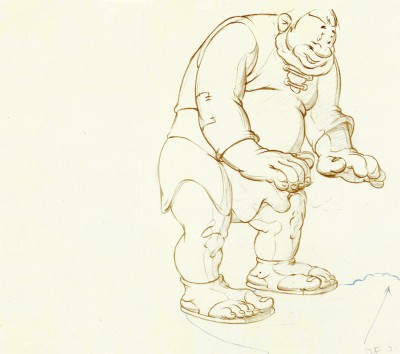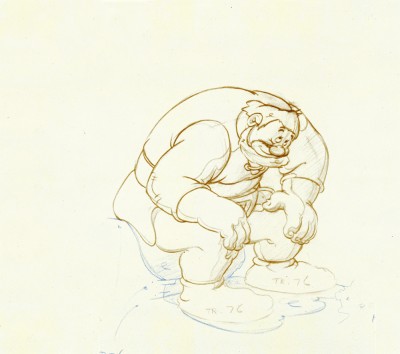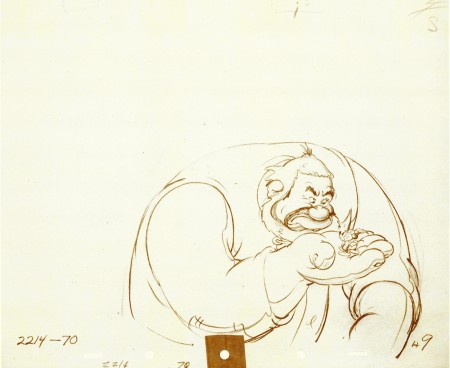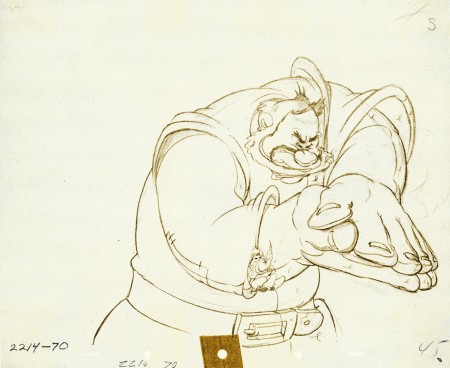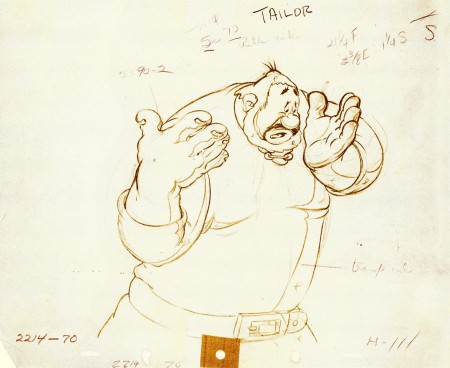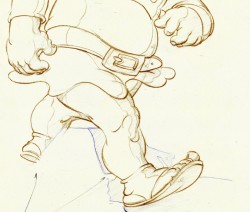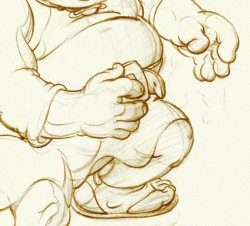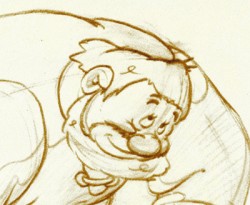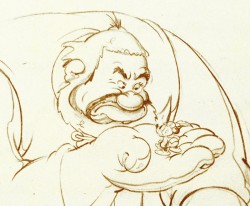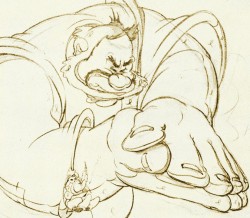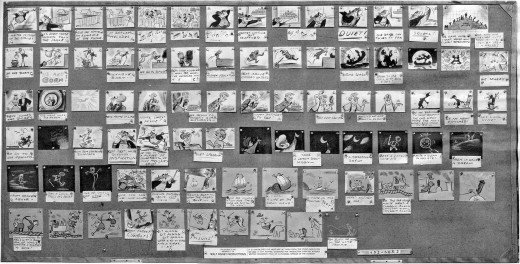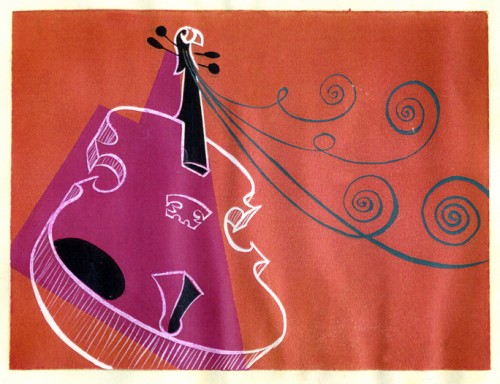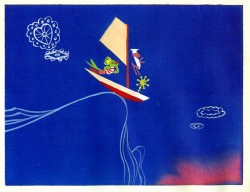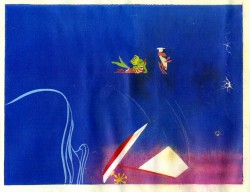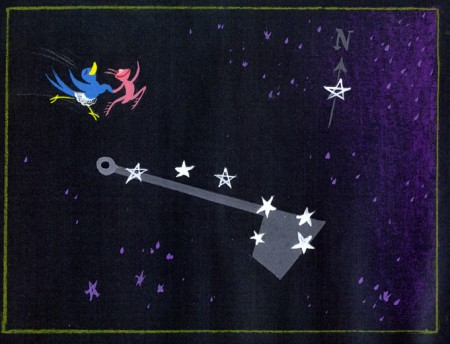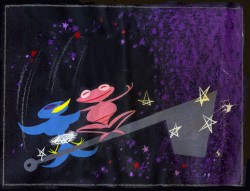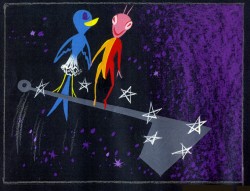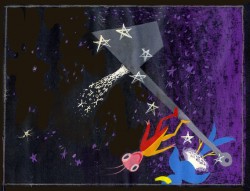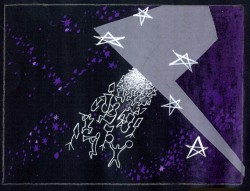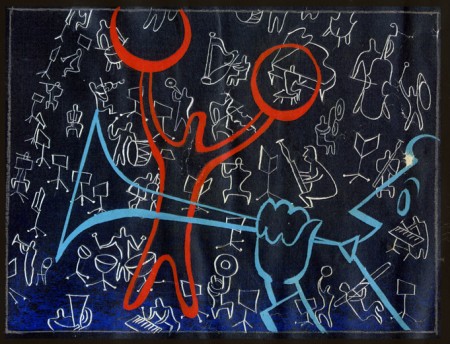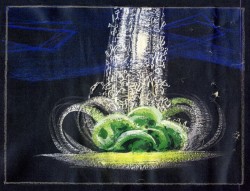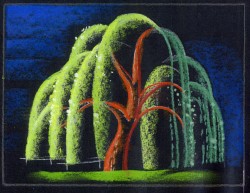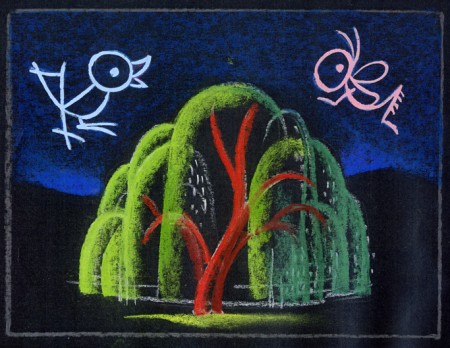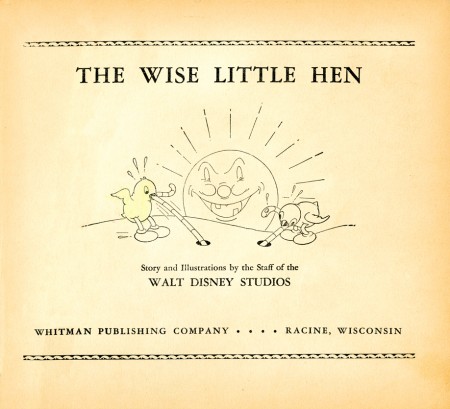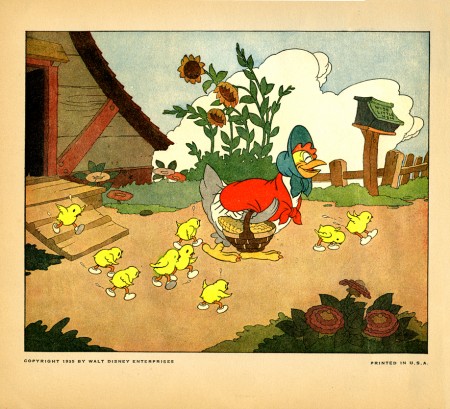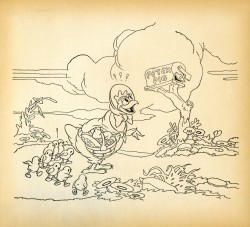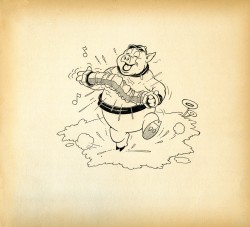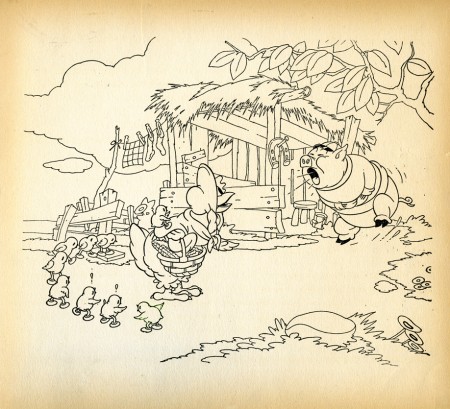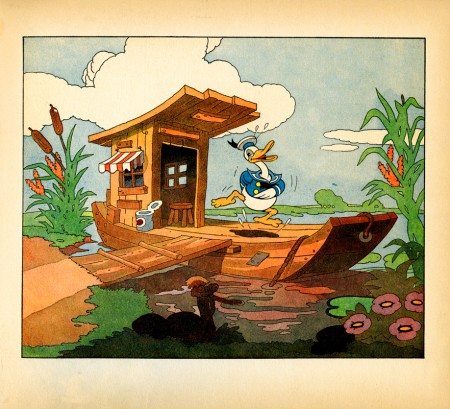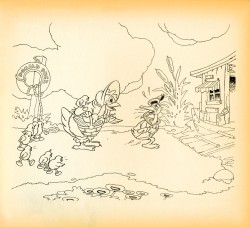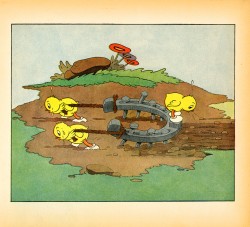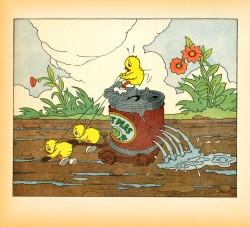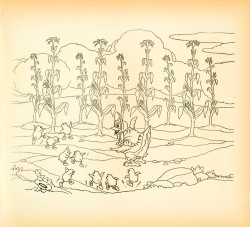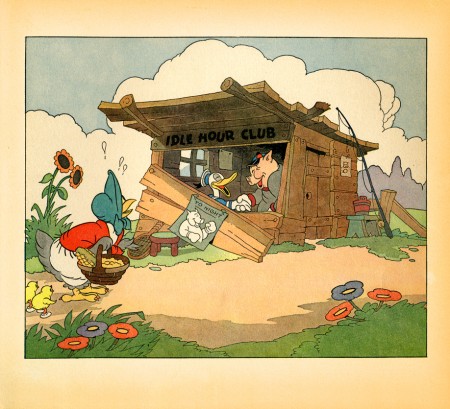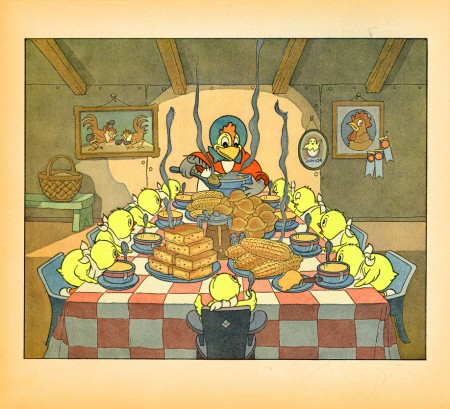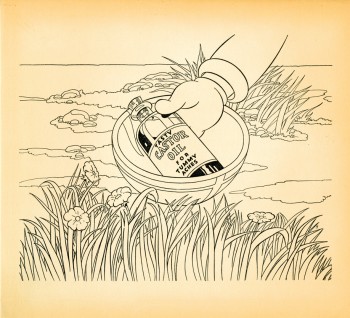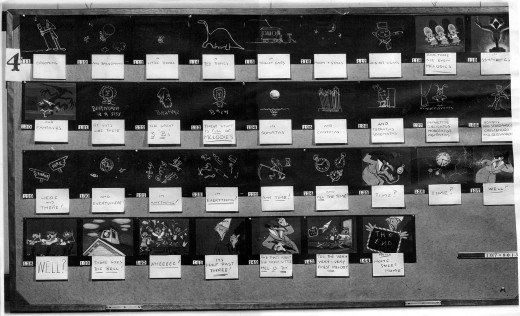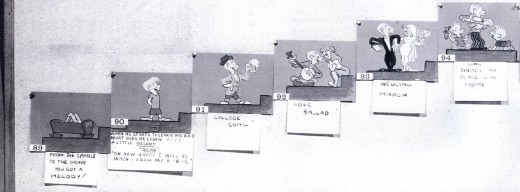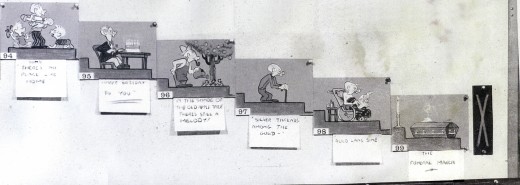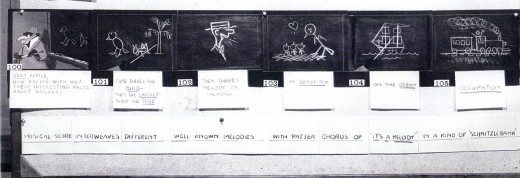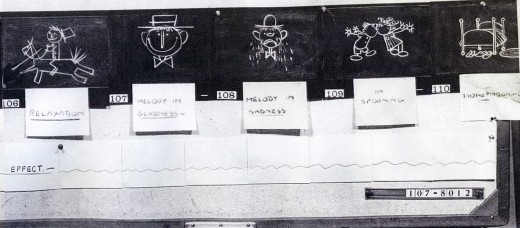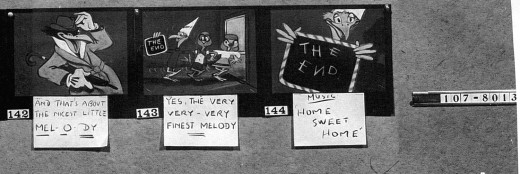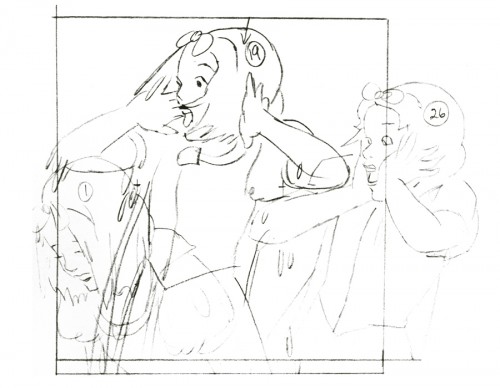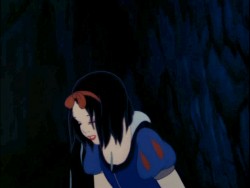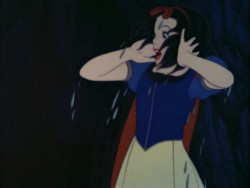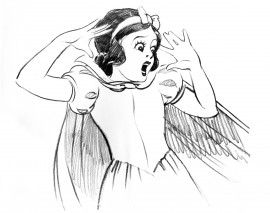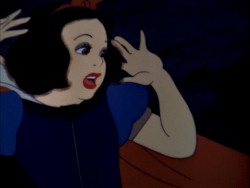Category ArchiveDisney
Animation Artifacts &Disney &Story & Storyboards 27 Oct 2008 08:10 am
Toot Bd – 1 pt 1
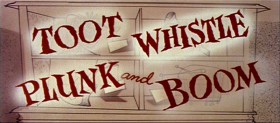 - Our Adventures in Music continue with the preliminary storyboard for what would ultimately become Toot Whistle Plunk & Boom. This is another board on loan from the archives of John Canemaker, and you can see the outgrowth from the prior film, Melody: Adventures in Music.
- Our Adventures in Music continue with the preliminary storyboard for what would ultimately become Toot Whistle Plunk & Boom. This is another board on loan from the archives of John Canemaker, and you can see the outgrowth from the prior film, Melody: Adventures in Music.
This material I’m posting here is on large photostat copies. The problem is that the images are a bit fuzzy, and the text beneath the boards is illegible. In some cases, the appropriate text has been hand written on the copies themselves.
This board is the first of two that I have, and it is five pages in size. Here are two.
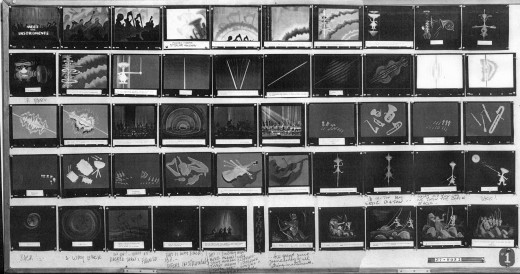
(Click any image to enlarge.)
These are breakdowns of each row of the two boards so that the images can be made as large as possible.
 11a
11a
I’ll have the remainder of the board up tomorrow.
.
Ward Jenkins has posted some beautiful frame grabs from the completed film. Go here.
Animation &Disney 23 Oct 2008 08:11 am
Thomas’ Mim
- Here’s a small bit of the Mad Madame Mim as animated by Frank Thomas. It’s not particularly enlightening, but I still enjoy looking at the drawings. I believe these drawings might have appeared in some publication or other but haven’t been able to locate them. (There are some other drawings in the Thomas/Johnston book, The Illusion of Life (pg 180-181), but I think that’s from another part of this scene.)
the most interesting part about these drawings is the breaking of joints as she turns her arms around with her body. (There’s a bit of odd foreshortening in her right arm on drawings 1 & 2.)
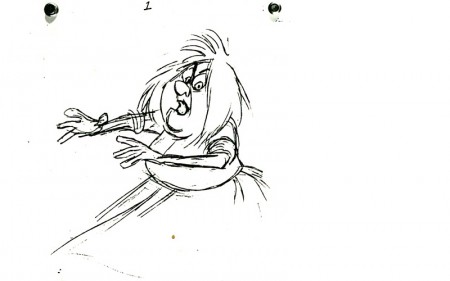 1
1(Click any image to enlarge.) Madame Mim turns.
Animation Artifacts &Disney &Story & Storyboards 20 Oct 2008 07:39 am
Revised Melody Bd – Pt 2
Here’s the final part of the revised storyboard for the Disney short, Melody: Adventures In Music. This version of the board was done in April ’52 and is closer to the final film (which was done in 3D.) See Part 1 here.
You’ll remember that I posted the first version of the board for this film in two parts here: Part 1 and Part 2. Many thanks to John Canemaker for the loan of all this material.
Here’s the whole board:
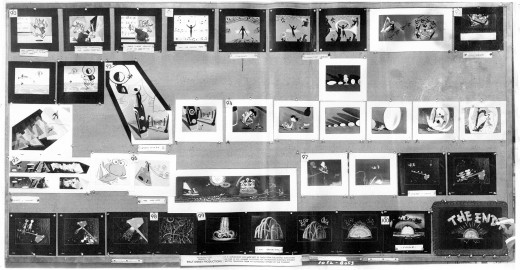
You’ll note that this board is configured oddly. You’ll also note that on each of the two photos there is a “THE END” card. I can only assume these are alternate endings.
Now, here is my breakdown of the board, trying to keep the size as large as possible so that you can read it.
 31a
31aYou’ll notice as you look through this part of the board that a lot of the
artwork sketches I posted in the past two weeks are displayed here.
Art part 1 and Art part 2
Next week, TOOT WHISTLE PLUNK & BOOM
.
Animation &Books &Disney 15 Oct 2008 08:13 am
Tytla’s Willie
- When I was a kid, I was never a big fan of the “Willie” character, the giant in Mickey & the Beanstalk. It seemed that every fourth or fifth Disneyland tv show would have this character in it (or else Donald and Chip & Dale). As I got older and grew a more educated eye for animation, I came to realize how well the character was drawn and animated.
Willie first appeared in the classic Mickey short, The Brave Little Tailor, and he appeared fully formed. Bill Tytlas was the animator, and he appeared to have fun doing it.
In John Canemaker‘s excellent book, Treasury of Disney Animation Art, there are some beautiful drawings worth looking at. Here they are:
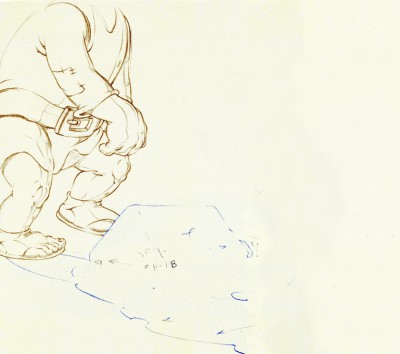 1
1(Click any image to enlarge.)
So let’s take a closer look at some of these drawings.
.
Drawing #3 features this weight shift. As the right foot hits the ground it pronates – twists ever so slightly inward. The hands do just the opposite. The left hand reaches in while the right hand holds back, completely at rest.
It’s a great drawing.
.
.
.
Drawing #4 shows Willie landing on that right foot, and his entire body tilts to the right. The hands twist completely to the left trying to maintain balance. The left foot up in the air is also twisting to the left before it lands twisting to the right.
.
.
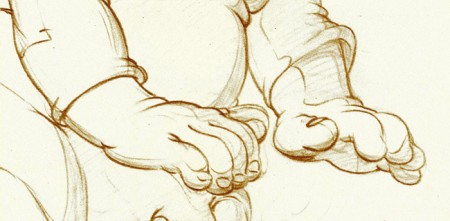
I love how drawing #5 features the two hands flattened out to
make his final stand before sitting down. It’s all about gaining balance.
.
.
.
.
Just take a look at this beautiful head in drawing #6. He’s seated, his head has come forward and tilted forward. The distortion is so beautiful it almost doesn’t look distorted.
What a fabulous artist! This guy just did this naturally.
.
.
.
This scene begins with the seated giant eyeing the tiny Mickey Mouse in his hand. The characters are drawn beautifully almost at a rest waiting to get into the scene. The intensity of Willie’s glare is strong, and it’s obvous Mickey is in trouble.
.
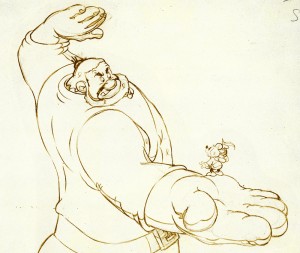 Here’s the drawing of the sequence.
Here’s the drawing of the sequence.
The major problem with drawing a giant is his proportion to all the other characters. The screen is more oblong and vertical than it is square. (Fortunately, when this film was done it was closer to a square but still not one.) Throughout the film, Tytla had to deal with a BIG and Mickey and the landscape are small.
An obvious way of handling it – and one that would be done today, no doubt – would be to force perspective showing it from the ground up – most of the time. In the 30′s and 40′s they stuck to the traditional rule of film and editing, and they would NOT have done this.
Tytla plays with scale as the giant steps over a house and ultimately sits on it.
In this drawing, he does a brilliant drawing forcing the perspective with Mickey in the foreground and Willie’s left hand in the distance. The giant draws into this forceful perspective without calling attention to itself. Today it would be more exaggerated, but Tytla doesn’t want it to be noticed – just felt.
A real bit of art!
Here, Willie moves through that perspective of the last extreme, and he gets larger as he slams his hands to flatten Mickey. To exaggerate that flattening, Willie’s hands flatten for this key drawing. His head flattens as well in grimace.
The giant’s head will move in toward the hands to see the results, and the audience has a front row seat seeing Mickey escape up the giant’s sleeve. There’s a lot going on in this drawing.
.
.

Finally, Willie tries to figure out what’s happened.
The drawing loses most of its distortion and comes to rest.
(Note that there’s still perspective distancing between the two hands.)
Mark Mayerson has done a mosaic breakdown of this cartoon and adds his excellent commentary.
Animation Artifacts &Disney &Story & Storyboards 13 Oct 2008 08:12 am
Revised Melody Bd – Pt 1
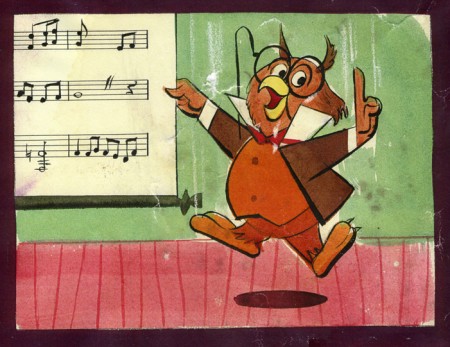 - Last week, I concluded with the original storyboard for Melody: Adventures In Music.
- Last week, I concluded with the original storyboard for Melody: Adventures In Music.
Now, I’d like to present the new and improved, revised version which was done in April ’52. This one is closer to the final film (which was done in 3D.)
As with all the other posted Diseny boards, a large bow of thanks is owed to John Canemaker for lending me this material from his collection.
Here, as usual, I offer the original boards as photographed:
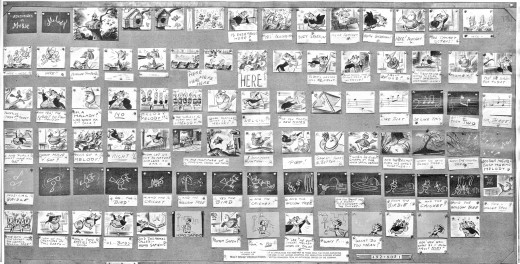
(Click any image to enlarge.)
Now, here are the rows of the board broken so as to post them as large as possible.
The remainder of this board will be posted next Monday.
.
Daily post &Disney 11 Oct 2008 08:32 am
Bashir’s Oscar, Mickey’s voice
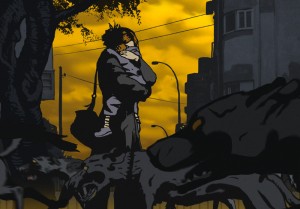 Ari Folman’s Waltz With Bashir has been submitted by Israel as its contender for the foreign-language Oscar.
Ari Folman’s Waltz With Bashir has been submitted by Israel as its contender for the foreign-language Oscar.
The film is also eligible for animated feature, but not for documentary. As reported in Variety, the film has instigated some complaints to the Academy over their documentary rules. Currently, a doc has to perform in NYC for a week prior to Aug. 31st to be eligible. If Sony Pictures Classics had followed this rule to qualify, the film could not have participated in the NY Film Festival.
A host of executives and festival veterans are calling on the Academy of Motion Picture Arts and Sciences to revise the rule. However, if the Academy does agree to change the rule, it wouldn’t help Bashir since the revised rule wouldn’t go into effect until 2009.
The film uses hand-drawn animation to illustrate Folman’s interviews with participants of the 1980s Lebanese war, including the massacre of Palestinian civilians. It was done, primarily, in Flash, and moves pretty stiffly. In fairness, I have to say I wasn’t overwhelmed by the film, so I suspect it’s not a challenge to either Religulous or Wall-E (not that I can say I liked either of those).
 -Tuesday, September 30th marked the 80th anniversary of Mickey Mouse’s big sound recording. It was the second session that took three hours and ended brilliantly.
-Tuesday, September 30th marked the 80th anniversary of Mickey Mouse’s big sound recording. It was the second session that took three hours and ended brilliantly.
The film didn’t debut until November 18th when it opened at the Colony Theater in NYC. This theater was enormous, similar to Radio City Music Hall or the Roxy. There was a stageshow with the feature film as well as numerous shorts. In 1928, the Mickey Mouse cartoon was a hit – audiences demanded the cartoon be shown more than once on the program.
This small landmark passed virtually unnoticed, even on the blogosphere. The only site I know that mentioned it was Joe Campana‘s Animation Who & Where.
Perhaps things will be different for the November anniversary of it’s theatrical debut. I vividly remember the 50th Anniversary when they screened Steamboat Willie again at the Colony (now the Broadway Theater)for some invited guests and a bunch of stragglers, myself included. Of course, two other shorts were released earlier that same year in their silent version: Plane Crazy and Gallopin’ Gauchos.
- Speaking of Mickey Mouse, much has been made of the demotion of Glen Keane from director of Rapunzel to Directing Animator. The Cartoon Brew piece has generated quite a few comments and most of them bemoan the action taken by producers Lasseter and Catmull on the upcoming feature (projected release 2010). Keane has been involved as director for the past seven years.
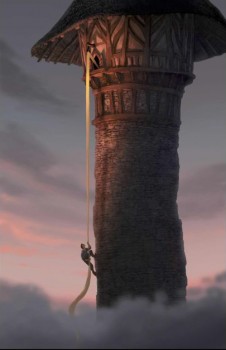 My view is a bit different (and of course I have no information other than my own guesswork to go on) on the situation. Consequently, if anyone has a more informed psition, plese let me hear it.
My view is a bit different (and of course I have no information other than my own guesswork to go on) on the situation. Consequently, if anyone has a more informed psition, plese let me hear it.
I think that Disney has never treated directors of their animation features as any more than glorified production coordinators. They work incredibly hard to keep the people below them happy while at the same time trying to satisfy the wishes and needs of those above them. There are a lot of people above them these days. It becomes a position of controlling traffic and keeping the ship sailing fluidly. It’s not about opinion.
Certainly, directors have their say and their influence, but the Animation Directors have always dominated at Disney. You can’t tell me that Woolie Reitherman won many arguments directing Milt Kahl on any of the films – or Frank Thomas, or Marc Davis. These guys worked together intimately, but Fred Moore or Ward Kimball or Bill Tytla had their say, and Ben Sharpsteen or David Hand kept them happy while making sure Walt was happy.
This was very much unlike the situation at WB where a Chuck Jones or Bob Clampett ruled and was the most heard voice in the production. Animators, there, were certainly subservient to the directors.
Undoubtedly, this had to do with the budget of the WB cartoons over the Disney product. The single voice of the WB films dominated because they had to control every penny – it was too tight. Action, cutting, layout, even writing were subject to the budget, and the directors made sure they came in on that budget.
At Disney’s this became the rule in many of the later shorts, such as Toot Whistle Plunk and Boom where the director like Ward Kimball and the budget dominated, but, for the most part, the animators ruled at Disney.
Glen Keane’s move back to animation – excuse me, Directing Animator – is, in my eyes, a promotion. Lasseter and Catmull had to bring out the real Glen Keane while getting the production moving. (There also seems to be more involved than we’ve heard. Ed Catmull reports that Keane had to “attend to some non-life threatening health issues.†Of course this doesn’t explain why co-director Dean Wellins “removed himself.”)
Animation Artifacts &Disney &Story & Storyboards 10 Oct 2008 08:17 am
Melody Art – 2
- Having completed posting the first storyboard to the Disney short, Melody: Adventures In Music I’d like to complete my posting of the preliminary art and boards for this film. I’d displayed the first half of this artwork last week.
Needless to say, John Canemaker has to be thanked many times over for lending me this rare material from his collection.
When the images have pegs on them (the black ones), I’ve given a complete scan in the enlarged version.
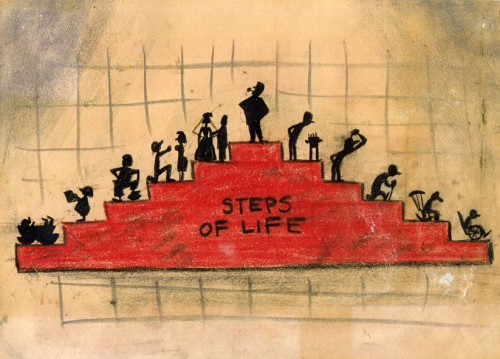
(Click any image to enlarge.)
Let me also repeat the following information. You can find frame grabs from this short on Ward Jenkins‘ site, The Ward-O-Matic.
MELODY is included in the Walt Disney Treasures: Disney Rarities dvd set and it is also found in the bonus features of the Fantasia 2000 dvd.
The film is also on YouTube (at the moment) in not the best condition.
Books &Comic Art &Disney &Illustration 09 Oct 2008 08:23 am
Wise Little Hen – Book
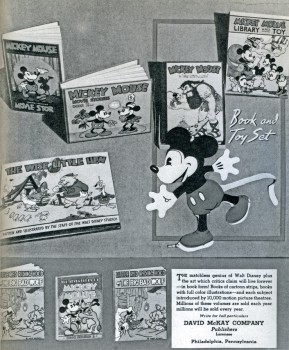 - Another gem from the collection of John Canemaker is this early book published by Whitman in 1935. The Silly Symphony short, The Wise Little Hen, introduced Donald Duck to the world on release of the film in 1934.
- Another gem from the collection of John Canemaker is this early book published by Whitman in 1935. The Silly Symphony short, The Wise Little Hen, introduced Donald Duck to the world on release of the film in 1934.
The book is a good example of some early merchandising by the Disney brothers. These books started out as Premium give-aways: for example Mickey Mouse, Mail Pilot was given away by the American Oil Company and Mickey Mouse Sails for Treasure Island was a premium for Kolynos Dental Cream.
The success of the books continued for many years, even after Whitman grew into the Western Publishing who released the Little Golden Books and many many comic books featuring Disney characters. _____________________________An early ad for the books.
Here are the illustrations for this book:
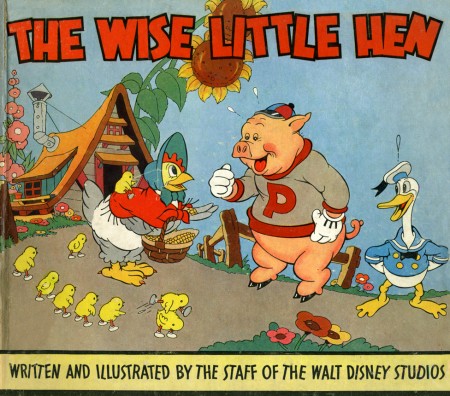
(Click any image to enlarge.)
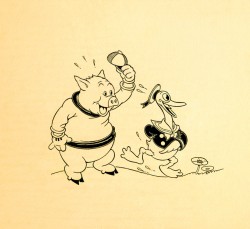
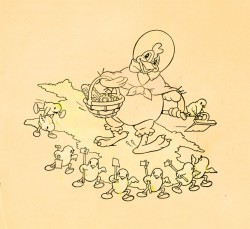
These two images greet you when you open the book.
They’re the inner cover for both the front and back of the book.
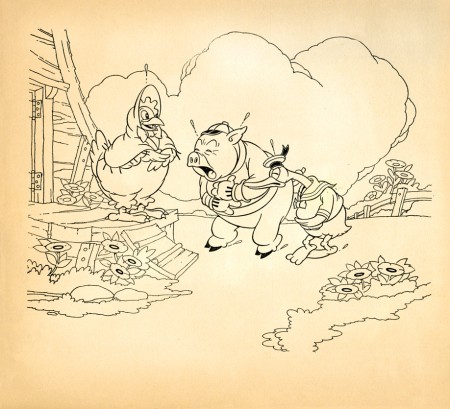
I wish Donald had continued to look like this. I love the way he looks in the film.
Animation Artifacts &Disney &Story & Storyboards 06 Oct 2008 08:12 am
Melody Board 1 – pt.2
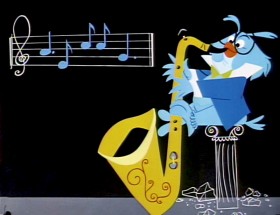 - Last week I posted the first part of the storyboard to the Disney short, Melody: Adventures in Music. This is another gem loaned to me by John Canemaker. It’s the first board to this short and has only some resemblance to the actual film.
- Last week I posted the first part of the storyboard to the Disney short, Melody: Adventures in Music. This is another gem loaned to me by John Canemaker. It’s the first board to this short and has only some resemblance to the actual film.
Next week, I’ll post a second board for the same film, one that looks very different and more like the final cartoon.
I’ve also posted some of the artist sketches for the film and will have more of those later this week.
Here are the last two storyboard panels in full size:
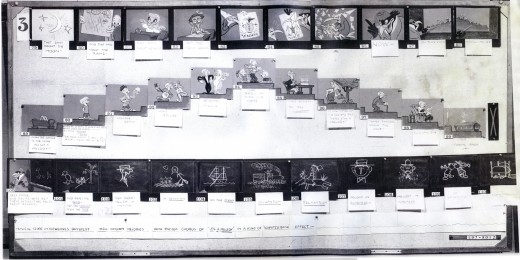
(Click any image to enlarge.)
Here are the rows of this board broken into halves so that I can get you the largest possible images:
You can find frame grabs from this short on Ward Jenkins‘ site, The Ward-O-Matic.
MELODY is included in the Walt Disney Treasures: Disney Rarities dvd set and it is also found in the bonus features of the Fantasia 2000 dvd.
Animation &Disney &repeated posts 04 Oct 2008 09:12 am
Rotocapture revisited
Rotoscoping got some attention back in January 2007 after a number of Motion Capture films were released. Here’s a post I did back then.
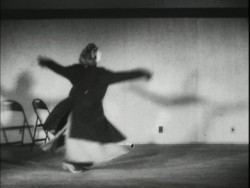 – A lot has been discussed in the past week about the validity of Motion Capture as a form of “Animation.” This conversation was instigated by the Oscar nominations. Two of the three nominations for the Best Animated Feature were created using MoCap.
– A lot has been discussed in the past week about the validity of Motion Capture as a form of “Animation.” This conversation was instigated by the Oscar nominations. Two of the three nominations for the Best Animated Feature were created using MoCap.
Mark Mayerson questioned if we shouldn’t be deciding whether we’re officially going to call Motion Capture animation. And if we shouldn’t, then is Cars the only officially nominated animated feature?
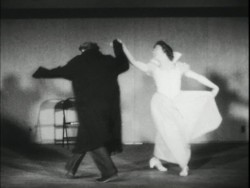 Now, of course, Motion Capture animators feel slighted. But they would have to agree that the soul, the impetus behind the movement does not come from them, but rather from the live action actor that was originally “captured”?
Now, of course, Motion Capture animators feel slighted. But they would have to agree that the soul, the impetus behind the movement does not come from them, but rather from the live action actor that was originally “captured”?
The comparison has been made that
traditional animation has often used Roto- scoping in creating animation. In fact, Disney’s Cinderella became the first feature that was wholly filmed in live action prior to 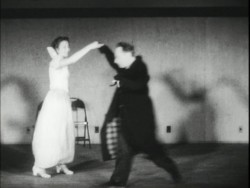
animation.
However, I’d like to make the point that the two methods are unrelated except in that live actors are involved. The difference to me, is that one is inspiration and the other is the heart of the animation.
When an animator is given live action reference material – the rotoscoped/traced drawings from the live action acting – he/she refers to it but animates to what is necessary for the scene. the animator is the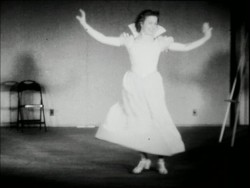 actor using the prerecorded voice, the physical rotoscoped reference, and anything available to help give the character a “soul.”
actor using the prerecorded voice, the physical rotoscoped reference, and anything available to help give the character a “soul.”
Even in Bakshi’s use of Rotoscoping in Lord of the Rings, the animators were allowed to push the drawings beyond the live action, alter the drawings to get them on character, and essentially produce the action.
When an “animator” gets the MoCap filmed live action, the actions are set. The actors have done the movement. What remains is 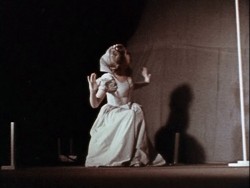 the proper positioning of the characters within the created scene, cleaning up the characters and constructing the scene. There’s no real animation, as we’ve come to know it.
the proper positioning of the characters within the created scene, cleaning up the characters and constructing the scene. There’s no real animation, as we’ve come to know it.
For years now, I’ve called this electronic puppetry, but that’s not really accurate. The site Digital Puppetry seems to have labelled it correctly.
Younger animators seem to have less a problem with all of this labelling and irritation accrued by older veterans. In fact, the 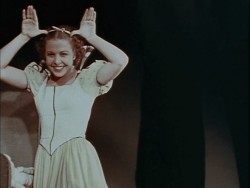 problem really is a threat to the “animator.” Last week, I hyperbolically suggested that the days of the animator were a dead as the dodo. You see, animation has turned into a computer effect. Live Action directors are now directing “animated films” in greater numbers. Peter Jackson had his “Gollum,” Robert Zemeckis had his “Polar Express” (and produced “Monster House”), Ang Lee had (and in fact acted) The Hulk. The “animators” have become interchangeable and almost irrelevant.
problem really is a threat to the “animator.” Last week, I hyperbolically suggested that the days of the animator were a dead as the dodo. You see, animation has turned into a computer effect. Live Action directors are now directing “animated films” in greater numbers. Peter Jackson had his “Gollum,” Robert Zemeckis had his “Polar Express” (and produced “Monster House”), Ang Lee had (and in fact acted) The Hulk. The “animators” have become interchangeable and almost irrelevant.
You aren’t able to define anyone’s animation style behind any of Tom Hanks’ characters in Polar Express. You can only see Tom Hanks or Savion Glover in Happy Feet.
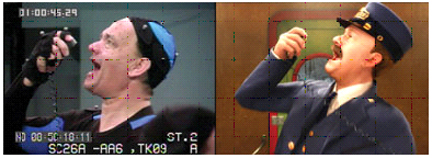
(All images except this one enlarge by clicking them.)
In Snow White, you can tell which scenes Grim Natwick animated; his style of animation comes across. It doesn’t matter how many rotoscoped drawings were given to him as reference. Grim animated the scenes.
In the big picture what really does all this quibbling matter? I enjoyed Happy Feet more than I did Cars. Cars was a better constructed film, both were riddled with cliches. I was entertained by all that dance. I like Savion Glover (though I would have preferred watching Savion Glover.) The film also seemed to have some sort of misguided representation of a message. I appreciated that. Cars, to me, had only a lot of loud noisy reverberation. From the first frame, the film came screaming. The artistry behind the imagery was astounding, as expected from Lasseter, but the film was boring.
Of course, this is only my opinion based on my biases. You have your opinions based on your biases. However, as an Academy voter, I’ll probably vote for Cars because I think technically it was a better “Animated” film. Isn’t that the category?
If you haven’t read Mark Mayerson on this subject, you should.
Ward Jenkins reminded me that he had two interesting posts about Polar Express on his site. It gives an interesting look at how to correct the “Zombie Eyes” on the characters. #1 and #2. Check them out, if you haven’t seen them.
